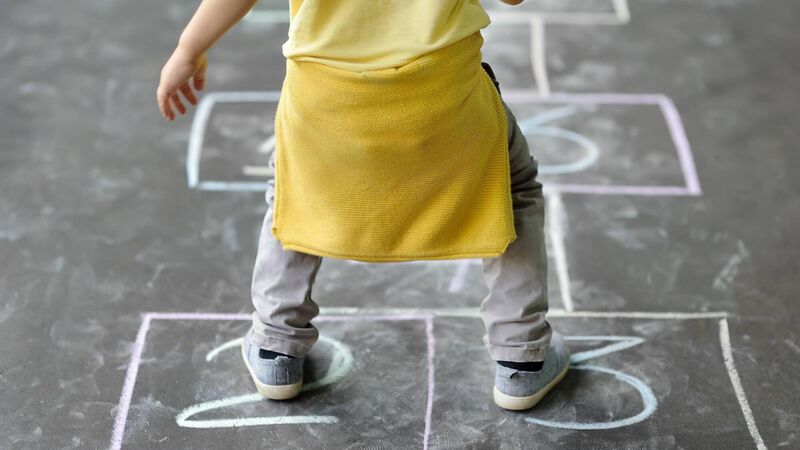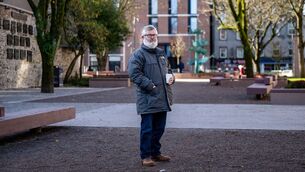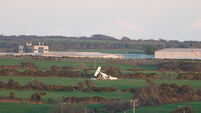Michael Moynihan: A successful city for children indicates a successful city for all

Pedestrianisation of streets, and removing the threat of traffic, will give play areas back to children.
Many thanks to the reader who got in touch after last week’s column on Cork’s obstacle-strewn streets.
I mentioned the challenges posed by street furniture to many people, including children and pram-pushing parents, and said reader drew parallels with modern cricket.
Namely, the disappearance of the street cricketer, with associated ramifications for professional cricket. Same for all sports, presumably, but my correspondent had a different take, pointing out the disappearance of the street game, full stop.
Ring a ring a rosy. Kerbs. Glassy alleys. Skipping. Conkers. Hopscotch. Pitch and toss. Even runaway knock. You don’t see kids outside playing those games in small gangs any more, and you don’t have to be a genius to guess the reason why.
I decided to drill into the subject with Denise Cahill of the HSE, the Healthy Cities Co-ordinator for Cork.
“It’s true, we don’t see children on the streets now. I think as a parent you’re balancing the fear of accidents and the fear of someone taking children, which is irrational, really, but is still something that’s in parents’ minds.
“The threat of traffic is the real issue. In UK there’s ‘Playing Out’, a scheme where streets can be closed for children to play, but we don’t have the necessary legislation in place for that here, though A Playful City in Dublin is trying to pursue that.
“But that loops back to another point — taking the natural element of play out, and going back to an adult-focused and directed activity. With Let’s Play Cork we were trying to let the children lead the play and let the adults step back.
“But it’s a very challenging area because we give cars such dominance. I know of estates in Cork which have tried to get ‘Slow — Children At Play’ sign erected and that’s a challenge in itself — raising money, getting everyone to agree to install the sign, and the cars are still whizzing past all the while.
“Unless we start to step out onto the streets and to become visible, and pedestrianising streets is a great way to do so.”
Pedestrianisation
Cahill pointed out that one advantage to pedestrianisation is children can then play “where you don’t have to pay to do so, or where you have to pay for a coffee to do so”, adding that Cork Healthy Cities is looking to work with Cork City Council on pedestrianisation: “They’re also interested in that, in fairness, in making pedestrianised zones more playful for children.”
There’s a hugely successful precedent for pedestrianisation in Cork, of course.
“What we did with the Marina was to close it for four Sundays in a row and we didn’t have to advertise it, children automatically went playing there, people liked it, and now it’s permanently pedestrianised.
“I think planners may not always think about children when planning and what we’re trying to work towards in Cork is a city that does plan for children because in planning for children you’re planning for everyone.
Children don’t demand much, they generally want just the space to play, and under the UN Convention they have the right to play anyway.
“I think we have an opportunity in Cork to make it a city that suits everyone and not just one group of people, whether that’s people who drink coffee, or who eat out — a city designed for everyone. And a play street idea is something we’d like to develop. What we’re about is rather than have playgrounds, often encased in a fence, is looking at the city itself as a playground.”
This was an interesting point. Does the creation of a specific playground in a park, for instance, mean kids are ‘catered for’, that that box is ticked?
“There can be a sense of ‘this is the only place you’re permitted to play’ with a playground — which can show up the fact that some playgrounds aren’t suitable for some children because they’re inaccessible for them.
“On the other hand, look at a park that’s full of trees and places to explore, which help the ideas of risky play and accessible play.
“By the way, a group that’s very much neglected in terms of public parks are teenage girls — those parks tend to be designed for smaller children, maybe older adults, and teenage boys when it comes to sports pitches and skateboarding.
“I know teenage girls play sports and skate as well, but a lot of them just want a space where they can hang out, where they’re not on display, and where they can just be together and chat. And we don’t design spaces like that, which are girl-friendly.”
Who does it well, then? There are good examples, says Cahill, not all of them that far away.
“Pontevedra in Spain, where the mayor reduced cars by ninety percent, that’s almost totally pedestrianised. Every age is catered for and you can see it in the numbers out walking the streets.
“Antwerp, Barcelona — those are good. There was a time we’d visit those places and then leave thinking, ‘this would never work in Cork because of insurance, the weather, etc’, but that all changed with covid. We were able to do a lot outdoors, and the Marina is a good example of something in Covid that persisted.
The language counts, too. We said we weren’t closing the Marina to traffic but opening it to play, focusing on ‘opening’, and people embraced it
“Cork City Council are doing their best in this area, too. The new Marina Park is a good example of that work, with hang-out spaces and different spaces, they’re open to moving with what’s current and inclusive in this area.”
The disappearance of the street game culture is regrettable, but Cahill points out that reality must also be acknowledged.
“I worry now that we’re slipping back a bit into more scheduled activities, but we have to recognise real life as well, in fairness.
“The way we live now dictates that, with both parents working, maybe commuting long distances, there’s a need for schedules. That’s just a fact of modern life.
“But that doesn’t change an essential truth. Seeing children out on the street is a good sign. It means an area is safe for them to be out on the street in the first place.”
Cahill and her colleagues are working on that. She mentions the Playful Culture Trail in Cork City in the summer of 2021 (“Danielle O’Donovan, formerly of Nano Nagle Place led the development and Cork City Council funded it”), cites Tim Gill’s Urban Playground (“A great resource”), while also adding that Cork is working on becoming a Child Friendly City, a proposal supported by Cork Healthy Cities.
“A former Mayor of Bogota, Enrique Peñalosa, said that children are an indicator species,” she says. “If you have a successful city for children, you have a successful city for all people.”
Time to take to the streets. In the best possible way.

Unlimited access. Half the price.
Try unlimited access from only €1.50 a week
Already a subscriber? Sign in
CONNECT WITH US TODAY
Be the first to know the latest news and updates











